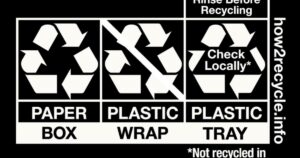
This article is sponsored by Rubicon.
The path to sustainability can be daunting for retail companies when considering the efforts needed to support both vast geographical footprints and an ever-changing diversity of product offerings.
For retail stores wanting to improve sustainability performance and lower environmental impacts, waste audits are an important tool. A waste audit is a formal, structured process used to quantify the amount and types of wastes being generated by an organization — which help identify current waste practices and how they can be improved.
Yet the term “waste audit” isn’t always the best way to describe these types of audits because not all items turn out to be waste — and the goal is to find ways to divert these resources. At Rubicon, we prefer to call these types of audits “material characterizations.” Material characterizations are systematic evaluations of material generated within retail environments. For retailers with diverse operations, these audits offer insight into their material streams and the types and volumes of materials being generated. The main objectives include identifying materials being discarded, assessing the efficacy of existing material management and recycling efforts and uncovering improvement areas.
Material characterizations are a foundational tool for helping sustainability professionals uncover data-driven insights to shape effective waste management strategies. However, the process comes with its own challenges as well as opportunities.
Challenges in conducting material characterizations
Conducting material characterizations in large retail environments is no small feat. Retail spaces can foster vast and often-changing material streams. Analyzing these streams demands careful planning, appropriate time and specialized resources pending the scope of the material characterization. Adding to the complexity is often scattered or missing waste data. Vital details such as generation rates, disposal costs and recycling figures are crucial for an effective audit.
Employee engagement is another pivotal element of a successful audit. Achieving meaningful understanding and active participation from employees, especially those not well-versed in material management principles, can be challenging. The inadvertent mixing of material streams poses another obstacle, as contamination complicates recycling or composting, threatening the success of these programs.
Lastly, when dealing with compactors, retailers face a unique set of logistical challenges. These challenges range from finding qualified auditors and synchronizing hauling schedules with vendors — especially amid challenges such as driver shortages — to grappling with space constraints essential for efficient material sorting. Navigating these challenges is crucial to ensure that the audit results are not only accurate but also actionable for sustainability professionals.
Opportunities presented by material characterizations
Material characterizations can lead to numerous opportunities for retailers. At the forefront is the discovery of waste reduction avenues. By precisely identifying key material types, retailers can implement strategies that lead to both significant cost savings and environmental benefits, including increased landfill diversion and the potential for lower annual waste output reporting.
Material characterizations offer a lens into the effectiveness or absence of critical recycling programs. Whether it’s identifying new opportunities for recycling or improvements to existing programs, or a need for enhanced education for employees, insights from an audit provide a clear roadmap for improvement or the re-assurance that the current approach is working successfully.
Another invaluable opportunity is the bolstering of a store’s sustainability reputation. In an era where consumers are increasingly thinking about their own sustainability practices, a proactive approach to sustainable materials management can elevate a store’s image, attracting more customers and instilling brand loyalty in environment where a growing number of patrons vote with their wallets. A study by Kerry found that one-third of all food produced globally goes to waste, and 98 percent of consumers say they are trying to reduce their food waste.
Additionally, material characterizations can serve as the foundation for broader initiatives. They can be leveraged to educate customers about sustainability practices or to engage suppliers in discussions about reducing waste, be it through minimalistic packaging or the adoption of more sustainable materials.
Real life considerations resulting from retailer audits
Below are some real-life considerations resulting from Rubicon-supported waste audits among a number of retailer customers:
Are you over-reporting tonnages in your annual waste reporting because you’re relying on Environmental Protection Agency (EPA) weight estimates when your actual generated waste is significantly lighter than the official estimates? Audits can identify consistencies that may allow retailers to adjust how they’re reporting waste each year, which will have a measurable impact on both landfill diversion percentages and total disposal tonnages.
Are you considering implementing a change to mixed recycling across your retail footprint? Data from an audit can tell a clear story on what the actual impact of mixed recycling may be. If retailers are finding a high percentage of mixed recyclables in their waste stream, this can serve as justification for pursuing a change to mixed recycling. Alternatively, if retailers are finding low percentages of mixed recyclables, they may find that resources are better spent towards opportunities with a greater measurable impact.
Are valuable commodities entering your waste stream that have the potential to be consolidated and recycled for a rebate vs. disposed of at a cost? Nearly every retail waste container contains a commodity that has value. Audits can give retailers the data to determine whether there is a tangible return on investment by consolidating this material in the form of both rebates and increased landfill diversion reporting.
Are your on-site waste services appropriately sized for each material stream? As important as it is to identify the actual material in a waste stream, empty volume or spillover of recycling into trash can help retailers make decisions about the service levels of both audited locations and the retail greater footprint pending what kind of consistency is found. This can have both a substantial cost and diversion reporting impact.
Auditing retail waste affords organizations an awesome opportunity — don’t let yours waste it. To learn more about how Rubicon can help your store improve your waste management processes, reach out to our Technical Advisory Services (TAS) team today.
- SEO Powered Content & PR Distribution. Get Amplified Today.
- PlatoData.Network Vertical Generative Ai. Empower Yourself. Access Here.
- PlatoAiStream. Web3 Intelligence. Knowledge Amplified. Access Here.
- PlatoESG. Carbon, CleanTech, Energy, Environment, Solar, Waste Management. Access Here.
- PlatoHealth. Biotech and Clinical Trials Intelligence. Access Here.
- Source: https://www.greenbiz.com/article/awesome-opportunity-auditing-retail-waste
- :has
- :is
- :not
- :where
- 98
- a
- About
- accurate
- achieving
- across
- active
- actual
- adding
- adjust
- Adoption
- advisory
- advisory services
- agency
- All
- allow
- also
- always
- Amid
- among
- amount
- an
- analyzing
- and
- annual
- Another
- approach
- appropriate
- appropriately
- ARE
- areas
- article
- AS
- Assessing
- At
- attracting
- audit
- audited
- auditing
- auditors
- audits
- avenues
- BE
- because
- being
- benefits
- BEST
- Better
- bolstering
- both
- brand
- brand loyalty
- broader
- but
- by
- call
- CAN
- careful
- challenges
- challenging
- change
- clear
- comes
- Commodities
- commodity
- Companies
- complexity
- conducting
- considerations
- considering
- consolidating
- constraints
- Consumers
- Container
- contains
- Cost
- cost savings
- Costs
- critical
- crucial
- Current
- Customers
- data
- data-driven
- dealing
- decisions
- demands
- describe
- details
- Determine
- discovery
- discussions
- disposal
- diverse
- Diversion
- Diversity
- divert
- Dont
- driver
- each
- educate
- Education
- Effective
- effectiveness
- efficacy
- efficient
- efforts
- element
- ELEVATE
- employees
- empty
- engage
- engagement
- enhanced
- ensure
- entering
- Environment
- environmental
- Environmental Protection Agency
- environments
- EPA
- Era
- especially
- essential
- estimates
- Ether (ETH)
- evaluations
- ever-changing
- Every
- existing
- Face
- feat
- Figures
- Find
- finding
- food
- Footprint
- For
- forefront
- form
- formal
- Foster
- found
- Foundation
- from
- generated
- generation
- geographical
- Give
- Globally
- goal
- Goes
- grappling
- greater
- Growing
- Have
- help
- helping
- High
- How
- However
- HTTPS
- identify
- identifying
- if
- image
- Impact
- Impacts
- implement
- implementing
- important
- improve
- improved
- improvement
- improvements
- in
- include
- Including
- increased
- increasingly
- initiatives
- insight
- insights
- into
- invaluable
- investment
- IT
- items
- ITS
- jpg
- Key
- Kind
- large
- lead
- LEARN
- Lens
- let
- levels
- leveraged
- Life
- lighter
- locations
- Low
- lower
- Loyalty
- Main
- make
- management
- material
- materials
- May..
- meaningful
- minimalistic
- missing
- mixed
- Mixing
- more
- navigating
- nearly
- Need
- needed
- New
- no
- number
- numerous
- objectives
- obstacle
- of
- offer
- Offerings
- official
- often
- on
- One-third
- only
- Operations
- opportunities
- Opportunity
- or
- organization
- organizations
- our
- out
- output
- own
- packaging
- participation
- path
- pending
- percent
- percentage
- performance
- pivotal
- planning
- plato
- Plato Data Intelligence
- PlatoData
- poses
- potential
- practices
- precisely
- prefer
- presented
- principles
- Proactive
- process
- processes
- Produced
- Product
- product offerings
- professionals
- Programs
- protection
- provide
- pursuing
- qualified
- range
- Rates
- reach
- Rebate
- rebates
- recycled
- recycling
- reduce
- reducing
- reduction
- relying
- Reporting
- reputation
- Resources
- resulting
- Results
- retail
- retailer
- retailers
- return
- roadmap
- Savings
- say
- scattered
- scope
- serve
- service
- Services
- set
- Shape
- shortages
- significant
- significantly
- sized
- small
- some
- Space
- spaces
- specialized
- spent
- Sponsored
- store
- stores
- Story
- strategies
- stream
- streams
- structured
- Study
- substantial
- success
- successful
- Successfully
- such
- suppliers
- support
- Sustainability
- sustainable
- tangible
- team
- tell
- term
- than
- that
- The
- their
- There.
- These
- they
- Thinking
- this
- those
- Through
- time
- to
- today
- tool
- Total
- towards
- trying
- TURN
- types
- uncover
- understanding
- unique
- used
- Valuable
- value
- Vast
- vendors
- vital
- volume
- volumes
- Vote
- vs
- Wallets
- wanting
- Waste
- Way..
- ways
- we
- weight
- WELL
- What
- when
- whether
- which
- will
- with
- within
- working
- year
- you
- Your
- zephyrnet






